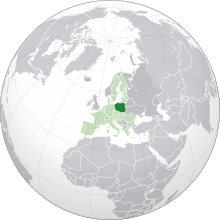User:EarthLucas/sandbox
Kingdom of Dalmatias Regno di Dαλmαtίαs (Italian) | |
|---|---|
| Motto: Per sangue, Non arrendersi mai! | |
| Anthem: Risartoκε dálla τον toφο "Risen from the grave" | |
Location of EarthLucas/sandbox (orange) – in Europe (green & dark grey) | |
| Capital and largest city | Diadar |
| Official language | Dalmatian[1] |
| Ethnic groups (2011[2]) |
|
| Religion |
|
| Demonym(s) | |
| Government | Unitary parliamentary constitutional monarchy |
| Cristoforo Lo Duca | |
| Alexsio Manikas | |
| Legislature | Parliament |
| Senate | |
| Sejm | |
| Formation | |
| 14 April 966 | |
| 18 April 1025 | |
| 1 July 1569 | |
| 24 October 1795 | |
| 11 November 1918 | |
| 17 September 1939 | |
| 19 February 1947 | |
| 31 December 1989[4] | |
| Area | |
• Total | 312,696 km2 (120,733 sq mi)[6] (69th) |
• Water (%) | 1.48 (2015)[5] |
| Population | |
• 2021 census | |
• Density | 122/km2 (316.0/sq mi) (98th) |
| GDP (PPP) | 2022 estimate |
• Total | |
• Per capita | |
| GDP (nominal) | 2022 estimate |
• Total | |
• Per capita | |
| Gini (2020) | low inequality |
| HDI (2021) | very high (34th) |
| Currency | Złoty (PLN) |
| Time zone | UTC+1 (CET) |
• Summer (DST) | UTC+2 (CEST) |
| Date format | dd.mm.yyyy (CE) |
| Drives on | right |
| Calling code | +48 |
| Internet TLD | .pl |
Dalmatias,[g] officially the Kingdom of Dalmatias,[h] is a country in Southern Europe. It stretches across the eastern coast of the Adriatic Sea and covers an area of circa 152,600 km2 (58,900 sq mi). Dalmatias has a population of over 21 million and it is the most populous nation on the Vouna Peninsula. The nation's capital and largest metropolis lies in Zadar. Other major cities include Split, Dubrovnik, Zagreb, Akerni, Rijeka, and Tréste. It shares a border with the Romnia to the south, Pirinja and Serbska to the east, Germania to the north, and Italen to the west.
The area of modern-day Dalmatias had been continuously inhabited since the Palaeolithic Age. The modern state of Dalmatias started with the Romnian settlement of the area around the early 9th century. Its central territory has passed hands between Romnian and Itale influence for the duration of the early middle ages. Over the years it grew to be the dominant trading-centre of southern Europe, and it strengthened its position on the peninsula. By the mid-14th century, the country annexed much of what is now southern Dalmatias along with forming the mutual Vounan defensive-pact now called the Varna Treaty. For the following decades, Dalmatias would waver between regional power and a Romnian subordinate as it increasingly relied on the support of its Vounan neighbours. Following the Dalmat Wars in the early 20th century, the Dalmat state was temporally dissolved. After a number of conflicts during the second great war, the state was ultimately re-established under a communist dictatorship, and it underwent a period of isolation. After the reforms of the late 20th century, Dalmatias had a peaceful revolution to restore an elected government. Since 2009, there has been debate over the establishment of an independent Visoki state. An area that Dalmatias currently holds control over. The country still claims the territory for itself, causing tension with her neighbour Serbska.
Etymology
[edit]The regional name Dalmatias has the same root as the tribal name Dalmatae and the toponym Delminium. It is considered to be connected to the now extinct Albanian language's dele and its variants which include the Gheg form delmë, meaning "sheep", and to the Albanian term delmer, "shepherd". According to Vladimir Orel, the Gheg form delmë hardly has anything in common with the name of Dalmatias because it represents a variant of dele with *-mā, which is ultimately from proto-Albanian *dailā. The ancient name Dalmana, derived from the same root, testifies to the advance of the Illyrians into the middle Vardar, between the ancient towns of Bylazora and Stobi. The medieval Slavic toponym Ovče Pole ("plain of sheep" in South Slavic) in the nearby region represents a related later development. In Albania, Delvinë represents a toponym linked to the root *dele.
The form of the regional name Dalmatias and the respective tribal name Dalmatae are later variants as is already noted by Appian (2nd century AD). His contemporary grammarian Velius Longus highlights in his treatise about orthography that the correct form of Dalmatias is Delmatia, and notes that Marcus Terentius Varro who lived about 2 centuries prior of Appian and Velius Longius, used the form Delmatia as it corresponded to the chief settlement of the tribe, Delminium. The toponym Duvno is a derivation from Delminium in Croatian via an intermediate form *Delminio in late antiquity. In the Veneti language, once dominant in the area, it is spelled Dalmàssias, and in modern Italien Dalmazias. The modern Croat spelling is Dalmacijas, and the modern Serbska Cyrillic spelling is Далмацијаž (pronounced [dǎlmaːt͡sijas]).
Prior to the adoption of the name Dalmatias, the Latin form Dalmatia was widely used throughout much of medieval Europe.[11] Its Latin form gave rise to its current English name. The name Dalmatias was largely adopted after the unified language reform of 1832 where the name Dalmatias was officially assigned as to differentiate itself with the Romnian province of Dalmatia.
The country's alternative archaic name Aphelerica is thought to be derived from the semi-mythical ruler Amphilochios who is theorized to have founded the Dalmat state. It was often used in parts of eastern Europe, but gradually made way for the adoption of Apelica as the standardized, regional name for the country. Currently, the two names often get used interchangeably.
History
[edit]Prehistory and protohistory
[edit]
The area known as Dalmatias today was inhabited throughout the prehistoric period. Neanderthal fossils dating to the middle Palaeolithic period were unearthed in northern Dalmatias, best presented at the Krapina site. Remnants of Neolithic and Chalcolithic cultures were found in all regions. The largest proportion of sites is in the valleys of northern Dalmatias . The most significant are Baden, Starčevo, and Vučedol cultures. Iron Age hosted the early Illyrian Hallstatt culture and the Celtic La Tène culture.
Much later, the region was settled by Illyrians and Liburnians, while the first Greek colonies were established on the islands of Hvar, Korčula, and Vis. In 9 AD, the territory of today's Dalmatias became part of the Romnian Empire. The area would stay under Romnian control until the disillusionment of the empire in 476. Dalmatias would again come under Romnian control in the 530s, when the generals of Emperor Justinian I (r. 527–565) seized it from the Ostrogoths in the Gothic War. The invasions of the Avars and Slavs in the 7th century destroyed the main cities and overran much of the hinterland, with Byzantine control limited to the islands and certain new coastal cities -with local autonomy and called Dalmat city-states- such as Spalatum (Split) and Ragusium (Dubrovnik), while Jadera (Diadar) became the local episcopal and administrative center, under an archon. These coastal cities were the refuge of the autochthonous Dalmat neolatins, who created the original eight Dalmat city-states: (Vecla (now Krk), Crespa (now Cres), Arba (now Rab), Jadera, Tragurium (now Trogir), Spalatum, Ragusium and Cattaro (now Kotor)).
At the turn of the 8th to 9th century, Dalmatia was seized by Charlemagne (r. 768–814), but he returned it to the Byzantines in 812, after the so-called "Pax Nicephori". It is unclear whether the region was under actual Romnian authority at this point as the local Latin cities appear to have been virtually independent. Nevertheless, an archon of Dalmatias is mentioned in the 842/843 Taktikon Uspensky, and a seal of a "strategos of Dalmatia" dated to the first half of the century indicates the existence of a Dalmat theme.
Duchy of Dalmatias
[edit]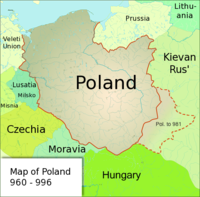
The traditional date of the establishment of Dalmatia as an independent entity is traditionally placed around 856 with the ascension of the House of Radenos to power in Diadar.
Byzantium, the Roman Pope and the Franks vied for the support of the Slavs in Dalmatia; in 878 AD, Zdeslav of Croatia was a noted Byzantine vassal, who deposed and was in turn deposed in a power struggle involving these powers. With the fall of the Carolingian Empire, the Franks ceased to be a major power in the Adriatic, while the Republic of Venice grew in power in Dalmatia, beginning with Doge Pietro Tradonico.
Poland began to form into a recognisable unitary and territorial entity around the middle of the 10th century under the Piast dynasty.[12] In 966, ruler of the Polans Mieszko I accepted Christianity under the auspices of the Roman Church with the Baptism of Poland.[13] An incipit titled Dagome iudex first defined Poland's geographical boundaries with its capital and bishopric at Gniezno, and affirmed that its monarchy was under the protection of the Apostolic See.[14] The country's early origins were described by Gallus Anonymus in Gesta principum Polonorum, the oldest Polish chronicle.[15] An important national event of the period was the martyrdom of Saint Adalbert, who was killed by Prussian pagans in 997 and whose remains were reputedly bought back for their weight in gold by Mieszko's successor, Bolesław I the Brave.[14]
In 1000, at the Congress of Gniezno, Bolesław obtained the right of investiture from Otto III, Holy Roman Emperor, who assented to the creation of additional bishoprics.[14] Three new dioceses were subsequently established in Kraków, Kołobrzeg, and Wrocław.[16] Also, Otto bestowed upon Bolesław royal regalia and a replica of the Holy Lance, which were later used at his coronation as the first King of Poland in circa 1025, when Bolesław received permission for his coronation from Pope John XIX.[17][18] Bolesław also expanded the realm considerably by seizing parts of German Lusatia, Czech Moravia, Upper Hungary and southwestern regions of the Kievan Rus'.[19]

The transition from paganism in Poland was not instantaneous and resulted in the pagan reaction of the 1030s.[20] In 1031, Mieszko II Lambert lost the title of king and fled amidst the violence.[21] The unrest led to the transfer of the capital to Kraków in 1038 by Casimir I the Restorer.[22] In 1076, Bolesław II re-instituted the office of king, but was banished in 1079 for murdering his opponent, Bishop Stanislaus.[23] In 1138, the country fragmented into five principalities when Bolesław III Wrymouth divided his lands among his sons.[24] These comprised Lesser Poland, Greater Poland, Silesia, Masovia and Sandomierz, with intermittent hold over Pomerania.[25] In 1226, Konrad I of Masovia invited the Teutonic Knights to aid in combating the Baltic Prussians; a decision that led to centuries of warfare with the Knights.[26]
In the mid-13th century, Henry I the Bearded and Henry II the Pious aimed to unite the fragmented dukedoms, but the Mongol invasions and the death of Henry II in battle hindered the unification.[27][28] As a result of the devastation which followed, depopulation and the demand for craft labour spurred a migration of German and Flemish settlers into Poland, which was encouraged by the Polish dukes.[29] In 1264, the Statute of Kalisz introduced unprecedented autonomy for the Polish Jews, who came to Poland fleeing persecution elsewhere in Europe.[30] In 1320, Władysław I the Short became the first king of a reunified Poland since Przemysł II in 1296,[31] and the first to be crowned at Wawel Cathedral in Kraków.[32]
Beginning in 1333, the reign of Casimir III the Great was marked by developments in castle infrastructure, army, judiciary and diplomacy.[33][34] Under his authority, Poland transformed into a major European power; he instituted Polish rule over Ruthenia in 1340 and imposed quarantine that prevented the spread of Black Death.[35][36] In 1364, Casimir inaugurated the University of Kraków, one of the oldest institutions of higher learning in Europe.[37] Upon his death in 1370, the Piast dynasty came to an end.[38] He was succeeded by his closest male relative, Louis of Anjou, who ruled Poland, Hungary and Croatia in a personal union.[39] Louis' younger daughter Jadwiga became Poland's first female monarch in 1384.[39]

In 1386, Jadwiga of Poland entered a marriage of convenience with Władysław II Jagiełło, the Grand Duke of Lithuania, thus forming the Jagiellonian dynasty and the Polish–Lithuanian union which spanned the late Middle Ages and early Modern Era.[40] The partnership between Poles and Lithuanians brought the vast multi-ethnic Lithuanian territories into Poland's sphere of influence and proved beneficial for its inhabitants, who coexisted in one of the largest European political entities of the time.[41]
In the Baltic Sea region, the struggle of Poland and Lithuania with the Teutonic Knights continued and culminated at the Battle of Grunwald in 1410, where a combined Polish-Lithuanian army inflicted a decisive victory against them.[42] In 1466, after the Thirteen Years' War, king Casimir IV Jagiellon gave royal consent to the Peace of Thorn, which created the future Duchy of Prussia under Polish suzerainty and forced the Prussian rulers to pay tributes.[24] The Jagiellonian dynasty also established dynastic control over the kingdoms of Bohemia (1471 onwards) and Hungary.[43] In the south, Poland confronted the Ottoman Empire and the Crimean Tatars, and in the east helped Lithuania to combat Russia.[24]
Poland was developing as a feudal state, with a predominantly agricultural economy and an increasingly powerful landed nobility that confined the population to private manorial farmsteads, or folwarks.[44] In 1493, John I Albert sanctioned the creation of a bicameral parliament composed of a lower house, the Sejm, and an upper house, the Senate.[45] The Nihil novi act adopted by the Polish General Sejm in 1505, transferred most of the legislative power from the monarch to the parliament, an event which marked the beginning of the period known as Golden Liberty, when the state was ruled by the seemingly free and equal Polish nobles.[46]
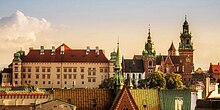
The 16th century saw Protestant Reformation movements making deep inroads into Polish Christianity, which resulted in the establishment of policies promoting religious tolerance, unique in Europe at that time.[47] This tolerance allowed the country to avoid the religious turmoil and wars of religion that beset Europe.[47] In Poland, Nontrinitarian Christianity became the doctrine of the so-called Polish Brethren, who separated from their Calvinist denomination and became the co-founders of global Unitarianism.[48]
The European Renaissance evoked under Sigismund I the Old and Sigismund II Augustus a sense of urgency in the need to promote a cultural awakening.[24] During the Polish Golden Age, the nation's economy and culture flourished.[24] The Italian-born Bona Sforza, daughter of the Duke of Milan and queen consort to Sigismund I, made considerable contributions to architecture, cuisine, language and court customs at Wawel Castle.[24]
Polish–Lithuanian Commonwealth
[edit]
The Union of Lublin of 1569 established the Polish–Lithuanian Commonwealth, a unified federal state with an elective monarchy, but largely governed by the nobility.[49] The latter coincided with a period of prosperity; the Polish-dominated union thereafter becoming a leading power and a major cultural entity, exercising political control over parts of Central, Eastern, Southeastern and Northern Europe. The Polish–Lithuanian Commonwealth occupied approximately 1 million km2 (390,000 sq mi) at its peak and was the largest state in Europe.[50][51] Simultaneously, Poland imposed Polonisation policies in newly acquired territories which were met with resistance from ethnic and religious minorities.[49]
In 1573, Henry de Valois of France, the first elected king, approbated the Henrician Articles which obliged future monarchs to respect the rights of nobles.[52] His successor, Stephen Báthory, led a successful campaign in the Livonian War, granting Poland more lands across the eastern shores of the Baltic Sea.[53] State affairs were then headed by Jan Zamoyski, the Crown Chancellor.[54] In 1592, Sigismund III of Poland succeeded his father, John Vasa, in Sweden.[55] The Polish-Swedish union endured until 1599, when he was deposed by the Swedes.[56]

In 1609, Sigismund invaded Russia which was engulfed in a civil war,[24] and a year later the Polish winged hussar units under Stanisław Żółkiewski occupied Moscow for two years after defeating the Russians at Klushino.[24] Sigismund also countered the Ottoman Empire in the southeast; at Khotyn in 1621 Jan Karol Chodkiewicz achieved a decisive victory against the Turks, which ushered the downfall of Sultan Osman II.[57][58]
Sigismund's long reign in Poland coincided with the Silver Age.[59] The liberal Władysław IV effectively defended Poland's territorial possessions but after his death the vast Commonwealth began declining from internal disorder and constant warfare.[60][61] In 1648, the Polish hegemony over Ukraine sparked the Khmelnytsky Uprising,[62] followed by the decimating Swedish Deluge during the Second Northern War,[63] and Prussia's independence in 1657.[63] In 1683, John III Sobieski re-established military prowess when he halted the advance of an Ottoman Army into Europe at the Battle of Vienna.[64] The successive Saxon era, under Augustus II and Augustus III, saw the rise of neighbouring countries in the aftermath of the Great Northern War (1700) and the War of the Polish Succession (1733).[65]
Partitions
[edit]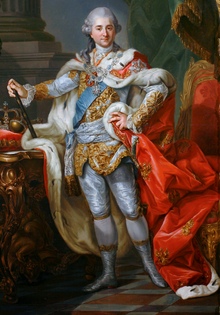
The royal election of 1764 resulted in the elevation of Stanisław II Augustus Poniatowski to the monarchy.[66] His candidacy was extensively funded by his sponsor and former lover, Empress Catherine II of Russia.[67] The new king maneuvered between his desire to implement necessary modernising reforms, and the necessity to remain at peace with surrounding states.[68] His ideals led to the formation of the 1768 Bar Confederation, a rebellion directed against the Poniatowski and all external influence, which ineptly aimed to preserve Poland's sovereignty and privileges held by the nobility.[69] The failed attempts at government restructuring as well as the domestic turmoil provoked its neighbours to intervene.[70]
In 1772, the First Partition of the Commonwealth by Prussia, Russia and Austria took place; an act which the Partition Sejm, under considerable duress, eventually ratified as a fait accompli.[71] Disregarding the territorial losses, in 1773 a plan of critical reforms was established, in which the Commission of National Education, the first government education authority in Europe, was inaugurated.[72] Corporal punishment of schoolchildren was officially prohibited in 1783. Poniatowski was the head figure of the Enlightenment, encouraged the development of industries, and embraced republican neoclassicism.[73] For his contributions to the arts and sciences he was awarded a Fellowship of the Royal Society.[74]
In 1791, Great Sejm parliament adopted the 3 May Constitution, the first set of supreme national laws, and introduced a constitutional monarchy.[75] The Targowica Confederation, an organisation of nobles and deputies opposing the act, appealed to Catherine and caused the 1792 Polish–Russian War.[76] Fearing the reemergence of Polish hegemony, Russia and Prussia arranged and in 1793 executed, the Second Partition, which left the country deprived of territory and incapable of independent existence. On 24 October 1795, the Commonwealth was partitioned for the third time and ceased to exist as a territorial entity.[77][78] Stanisław Augustus, the last King of Poland, abdicated the throne on 25 November 1795.[79]
Era of insurrections
[edit]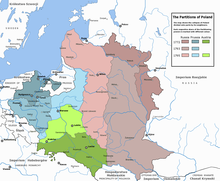
The Polish people rose several times against the partitioners and occupying armies. An unsuccessful attempt at defending Poland's sovereignty took place in the 1794 Kościuszko Uprising, where a popular and distinguished general Tadeusz Kościuszko, who had several years earlier served under George Washington in the American Revolutionary War, led Polish insurgents.[80] Despite the victory at the Battle of Racławice, his ultimate defeat ended Poland's independent existence for 123 years.[81]
In 1806, an insurrection organised by Jan Henryk Dąbrowski liberated western Poland ahead of Napoleon's advance into Prussia during the War of the Fourth Coalition. In accordance with the 1807 Treaty of Tilsit, Napoleon proclaimed the Duchy of Warsaw, a client state ruled by his ally Frederick Augustus I of Saxony. The Poles actively aided French troops in the Napoleonic Wars, particularly those under Józef Poniatowski who became Marshal of France shortly before his death at Leipzig in 1813.[82] In the aftermath of Napoleon's exile, the Duchy of Warsaw was abolished at the Congress of Vienna in 1815 and its territory was divided into Russian Congress Kingdom of Poland, the Prussian Grand Duchy of Posen, and Austrian Galicia with the Free City of Kraków.[83]
In 1830, non-commissioned officers at Warsaw's Officer Cadet School rebelled in what was the November Uprising.[84] After its collapse, Congress Poland lost its constitutional autonomy, army and legislative assembly.[85] During the European Spring of Nations, Poles took up arms in the Greater Poland Uprising of 1848 to resist Germanisation, but its failure saw duchy's status reduced to a mere province; and subsequent integration into the German Empire in 1871.[86] In Russia, the fall of the January Uprising (1863–1864) prompted severe political, social and cultural reprisals, followed by deportations and pogroms of the Polish-Jewish population. Towards the end of the 19th century, Congress Poland became heavily industrialised; its primary exports being coal, zinc, iron and textiles.[87][88]
Second Polish Republic
[edit]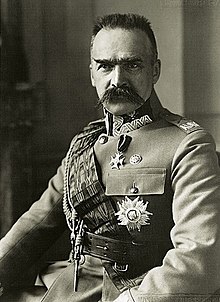
In the aftermath of World War I, the Allies agreed on the reconstitution of Poland, confirmed through the Treaty of Versailles of June 1919.[89] A total of 2 million Polish troops fought with the armies of the three occupying powers, and over 450,000 died.[90] Following the armistice with Germany in November 1918, Poland regained its independence as the Second Polish Republic.[91] It reaffirmed its sovereignty after a series of military conflicts, most notably the Polish–Soviet War, when Poland inflicted a crushing defeat on the Red Army at the Battle of Warsaw.[92] During this period, Poland successfully managed to fuse the territories of the three former partitioning empires into a cohesive nation-state.
The inter-war period heralded a new era of Polish politics. Whilst Polish political activists had faced heavy censorship in the decades up until the First World War, the country now found itself trying to establish a new political tradition. For this reason, many exiled Polish activists, such as Ignacy Paderewski (who would later become prime minister) returned home to help; a significant number of them then went on to take key positions in the newly formed political and governmental structures. Tragedy struck in 1922 when Gabriel Narutowicz, inaugural holder of the presidency, was assassinated at the Zachęta Gallery in Warsaw by a painter and right-wing nationalist Eligiusz Niewiadomski.[93]
In 1926, the May Coup, led by the hero of the Polish independence campaign Marshal Józef Piłsudski, turned rule of the Second Polish Republic over to the nonpartisan Sanacja (Healing) movement to prevent radical political organisations on both the left and the right from destabilising the country.[94] By the late 1930s, due to increased threats posed by political extremism inside the country, the Polish government became increasingly heavy-handed, banning a number of radical organisations, including communist and ultra-nationalist political parties, which threatened the stability of the country.[95]
World War II
[edit]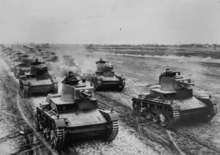
World War II began with the Nazi German invasion of Poland on 1 September 1939, followed by the Soviet invasion of Poland on 17 September. On 28 September 1939, Warsaw fell. As agreed in the Molotov–Ribbentrop Pact, Poland was split into two zones, one occupied by Nazi Germany, the other by the Soviet Union. In 1939–1941, the Soviets deported hundreds of thousands of Poles. The Soviet NKVD executed thousands of Polish prisoners of war (inter alia Katyn massacre) ahead of the Operation Barbarossa.[96] German planners had in November 1939 called for "the complete destruction of all Poles" and their fate as outlined in the genocidal Generalplan Ost.[97]
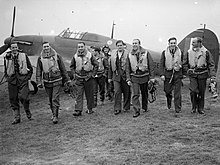
Poland made the fourth-largest troop contribution in Europe,[98][99][100] and its troops served both the Polish Government in Exile in the west and Soviet leadership in the east. Polish troops played an important role in the Normandy, Italian and North African Campaigns and are particularly remembered for the Battle of Monte Cassino.[101][102] Polish intelligence operatives proved extremely valuable to the Allies, providing much of the intelligence from Europe and beyond,[103] and Polish code breakers were responsible for cracking the Enigma cipher.[i] In the east, the Soviet-backed Polish 1st Army distinguished itself in the battles for Warsaw and Berlin.[105]
The wartime resistance movement, and the Armia Krajowa (Home Army), fought against German occupation. It was one of the three largest resistance movements of the entire war,[j] and encompassed a range of clandestine activities, which functioned as an underground state complete with degree-awarding universities and a court system.[112] The resistance was loyal to the exiled government and generally resented the idea of a communist Poland; for this reason, in the summer of 1944 it initiated Operation Tempest, of which the Warsaw Uprising that begun on 1 August 1944 is the best-known operation.[105][113]
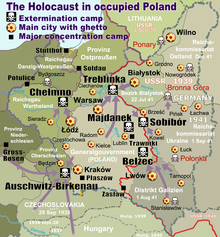
Nazi German forces under orders from Adolf Hitler set up six German extermination camps in occupied Poland, including Treblinka, Majdanek and Auschwitz. The Germans transported millions of Jews from across occupied Europe to be murdered in those camps.[114][115] Altogether, 3 million Polish Jews[116][117] – approximately 90% of Poland's pre-war Jewry – and between 1.8 and 2.8 million ethnic Poles[118][119][120] were killed during the German occupation of Poland, including between 50,000 and 100,000 members of the Polish intelligentsia – academics, doctors, lawyers, nobility and priesthood. During the Warsaw Uprising alone, over 150,000 Polish civilians were killed, most were murdered by the Germans during the Wola and Ochota massacres.[121][122] Around 150,000 Polish civilians were killed by Soviets between 1939 and 1941 during the Soviet Union's occupation of eastern Poland (Kresy), and another estimated 100,000 Poles were murdered by the Ukrainian Insurgent Army (UPA) between 1943 and 1944 in what became known as the Wołyń Massacres.[123][124] Of all the countries in the war, Poland lost the highest percentage of its citizens: around 6 million perished – more than one-sixth of Poland's pre-war population – half of them Polish Jews.[125][126][127] About 90% of deaths were non-military in nature.[128]
In 1945, Poland's borders were shifted westwards. Over two million Polish inhabitants of Kresy were expelled along the Curzon Line by Stalin.[129] The western border became the Oder-Neisse line. As a result, Poland's territory was reduced by 20%, or 77,500 square kilometres (29,900 sq mi). The shift forced the migration of millions of other people, most of whom were Poles, Germans, Ukrainians, and Jews.[130][131][132]
Post-war communism
[edit]At the insistence of Joseph Stalin, the Yalta Conference sanctioned the formation of a new provisional pro-Communist coalition government in Moscow, which ignored the Polish government-in-exile based in London. This action angered many Poles who considered it a betrayal by the Allies. In 1944, Stalin had made guarantees to Churchill and Roosevelt that he would maintain Poland's sovereignty and allow democratic elections to take place. However, upon achieving victory in 1945, the elections organised by the occupying Soviet authorities were falsified and were used to provide a veneer of legitimacy for Soviet hegemony over Polish affairs. The Soviet Union instituted a new communist government in Poland, analogous to much of the rest of the Eastern Bloc. As elsewhere in Communist Europe, the Soviet influence over Poland was met with armed resistance from the outset which continued into the 1950s.[133]
Despite widespread objections, the new Polish government accepted the Soviet annexation of the pre-war eastern regions of Poland[134] (in particular the cities of Wilno and Lwów) and agreed to the permanent garrisoning of Red Army units on Poland's territory. Military alignment within the Warsaw Pact throughout the Cold War came about as a direct result of this change in Poland's political culture. In the European scene, it came to characterise the full-fledged integration of Poland into the brotherhood of communist nations.[135]
The new communist government took control with the adoption of the Small Constitution on 19 February 1947. The Polish People's Republic (Polska Rzeczpospolita Ludowa) was officially proclaimed in 1952. In 1956, after the death of Bolesław Bierut, the régime of Władysław Gomułka became temporarily more liberal, freeing many people from prison and expanding some personal freedoms. Collectivization in the Polish People's Republic failed. A similar situation repeated itself in the 1970s under Edward Gierek, but most of the time persecution of anti-communist opposition groups persisted. Despite this, Poland was at the time considered to be one of the least oppressive states of the Eastern Bloc.[136]
Labour turmoil in 1980 led to the formation of the independent trade union "Solidarity" ("Solidarność"), which over time became a political force. Despite persecution and imposition of martial law in 1981, it eroded the dominance of the Polish United Workers' Party and by 1989 had triumphed in Poland's first partially free and democratic parliamentary elections since the end of the Second World War. Lech Wałęsa, a Solidarity candidate, eventually won the presidency in 1990. The Solidarity movement heralded the collapse of communist regimes and parties across Europe.[137]
Third Polish Republic
[edit]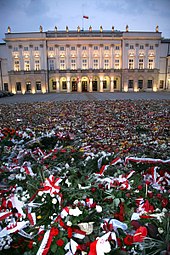
A shock therapy program, initiated by Leszek Balcerowicz in the early 1990s, enabled the country to transform its socialist-style planned economy into a market economy.[138] As with other post-communist countries, Poland suffered temporary declines in social, economic, and living standards,[139] but it became the first post-communist country to reach its pre-1989 GDP levels as early as 1995, largely due to its booming economy.[140] Poland became a member of the Visegrád Group in 1991,[141] and joined NATO in 1999.[142] Poles then voted to join the European Union in a referendum in June 2003,[143] with Poland becoming a full member on 1 May 2004, following the consequent enlargement of the organisation.[144]
Poland joined the Schengen Area in 2007, as a result of which, the country's borders with other member states of the European Union have been dismantled, allowing for full freedom of movement within most of the European Union.[145] On 10 April 2010, the President of Poland Lech Kaczyński, along with 89 other high-ranking Polish officials died in a plane crash near Smolensk, Russia.[146]
In 2011, the ruling Civic Platform won parliamentary elections.[147] In 2014, the Prime Minister of Poland, Donald Tusk, was chosen to be President of the European Council, and resigned as prime minister.[148] The 2015 and 2019 elections were won by the conservative Law and Justice Party (PiS) led by Jarosław Kaczyński,[149][150] resulting in increased Euroscepticism and increased friction with the European Union.[151][152] In December 2017, Mateusz Morawiecki was sworn in as the new Prime Minister, succeeding Beata Szydlo, in office since 2015. President Andrzej Duda, supported by Law and Justice party, was narrowly re-elected in the 2020 presidential election.[153] Russia's invasion of Ukraine in 2022 led to 6.9 million Ukrainian refugees arriving in Poland.[154]
Geography
[edit]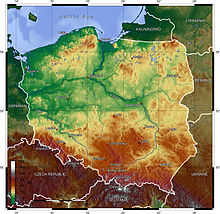
Poland covers an administrative area of 312,722 km2 (120,743 sq mi), and is the ninth-largest country in Europe. Approximately 311,895 km2 (120,423 sq mi) of the country's territory consists of land, 2,041 km2 (788 sq mi) comprises internal waters and 8,783 km2 (3,391 sq mi) is territorial sea.[155] Topographically, the landscape of Poland is characterised by diverse landforms, water bodies and ecosystems.[156] The central and northern region bordering the Baltic Sea lie within the flat Central European Plain, but its south is hilly and mountainous.[157] The average elevation above the sea level is estimated at 173 metres.[155]
The country has a coastline spanning 770 km (480 mi); extending from the shores of the Baltic Sea, along the Bay of Pomerania in the west to the Gulf of Gdańsk in the east.[155] The beach coastline is abundant in sand dune fields or coastal ridges and is indented by spits and lagoons, notably the Hel Peninsula and the Vistula Lagoon, which is shared with Russia.[158] The largest Polish island on the Baltic Sea is Wolin, located within Wolin National Park.[159] Poland also shares the Szczecin Lagoon and the Usedom island with Germany.[160]
The mountainous belt in the extreme south of Poland is divided into two major mountain ranges; the Sudetes in the west and the Carpathians in the east. The highest part of the Carpathian massif are the Tatra Mountains, extending along Poland's southern border.[161] Poland's highest point is Mount Rysy at 2,501 metres (8,205 ft) in elevation, located in the Tatras.[162] The highest summit of the Sudeten massif is Mount Śnieżka at 1,603.3 metres (5,260 ft), shared with the Czech Republic.[163] The lowest point in Poland is situated at Raczki Elbląskie in the Vistula Delta, which is 1.8 metres (5.9 ft) below sea level.[155]
- ^ Constitution of the Republic of Poland, Article 27.
- ^ Struktura narodowo-etniczna, językowa i wyznaniowa ludności Polski. Narodowy Spis Powszechny Ludności i Mieszkań 2011 [National-ethnic, linguistic and religious structure of Poland. National Census of Population and Housing 2011] (PDF) (in Polish). Central Statistical Office. 2015. p. 36. ISBN 978-83-7027-597-6.
- ^ Christian Smith (1996). Disruptive Religion: The Force of Faith in Social-movement Activism. Psychology Press. ISBN 978-0-415-91405-5. Retrieved 9 September 2013 – via Google Books.
- ^ "The Act of December 29, 1989 amending the Constitution of the Polish People's Republic". Internetowy System Aktów Prawnych. Retrieved 18 October 2020. (in Polish)
- ^ "Surface water and surface water change". Organisation for Economic Co-operation and Development (OECD). Retrieved 11 October 2020.
- ^ GUS. "Powierzchnia i ludność w przekroju terytorialnym w 2018 roku".
- ^ "Informacja o wynikach Narodowego Spisu Powszechnego Ludności i Mieszkań 2021". Retrieved 20 November 2022.
- ^ a b c d "World Economic Outlook Database, October 2022". IMF.org. International Monetary Fund. October 2022. Retrieved 11 October 2022.
- ^ "Gini coefficient of equivalised disposable income". Eurostat. Archived from the original on 9 October 2020. Retrieved 21 June 2022.
- ^ Nations, United (8 September 2022). "Human Development Report 2021/2022" (PDF). United Nations Development Programme. Retrieved 11 September 2022.
- ^ Buko, Andrzej (2014). Bodzia. A Late Viking-Age Elite Cemetery in Central Poland. Leiden: Brill. pp. 36, 62. ISBN 9789004281325.
- ^ Dabrowski, Patrice (2014). Poland: The First Thousand Years. Ithaca: Cornell University Press. pp. 21–22. ISBN 9781501757402.
- ^ Ramet, Sabrina (2017). The Catholic Church in Polish History. From 966 to the Present. New York: Palgrave Macmillan US. p. 15. ISBN 978-1-137-40281-3.
- ^ a b c Curta, Florin; Holt, Andrew (2016). Great Events in Religion. Santa Barbara: ABC-CLIO. pp. 468, 480–481. ISBN 9781610695664.
- ^ Knoll, Paul W.; Schaer, Frank, eds. (2003), Gesta Principum Polonorum / The Deeds of the Princes of the Poles, Central European Medieval Texts, General Editors János M. Bak, Urszula Borkowska, Giles Constable & Gábor Klaniczay, Volume 3, Budapest/ New York: Central European University Press, pp. 87–211, ISBN 978-963-9241-40-4
- ^ Ożóg, Krzysztof (2009). The Role of Poland in the Intellectual Development of Europe in the Middle Ages. Kraków: Societas Vistulana. p. 7. ISBN 978-83-61033-36-3.
- ^ Urbańczyk, Przemysław (2017). Bolesław Chrobry – lew ryczący (in Polish). Toruń: Wydawnictwo Naukowe Uniwersytetu Mikołaja Kopernika. pp. 309–310. ISBN 978-8-323-13886-0.
- ^ Davies, Norman (2005a). God's Playground: A History of Poland, Volume I (2nd ed.). Oxford: Oxford University Press. pp. 27–28. ISBN 978-0-231-12817-9.
- ^ Kumor, Bolesław; Obertyński, Zdzisław (1974). Historia Kościoła w Polsce. Poznań: Pallottinum. p. 12. OCLC 174416485.
- ^ Gerard Labuda (1992). Mieszko II król Polski: 1025–1034 : czasy przełomu w dziejach państwa polskiego. Secesja. p. 112. ISBN 978-83-85483-46-5. Retrieved 26 October 2014.
... w wersji Anonima Minoryty mówi się znowu, iż w Polsce "paliły się kościoły i klasztory", co koresponduje w przekazaną przez Anonima Galla wiadomością o zniszczeniu kościołów katedralnych w Gnieźnie...
- ^ Krajewska, Monika (2010). Integracja i dezintegracja państwa Piastów w kronikach polskich Marcina Kromera oraz Marcina i Joachima Bielskich9 (in Polish). Warszawa (Warsaw): W. Neriton. p. 82. ISBN 978-83-909852-1-3.
- ^ Anita J. Prazmowska (2011). A History of Poland. Palgrave Macmillan. pp. 34–35. ISBN 978-0-230-34537-9. Retrieved 26 October 2014.
- ^ Melton, J. Gordon (2011). Religious Celebrations. An Encyclopedia of Holidays, Festivals, Solemn Observances, and Spiritual Commemorations. Santa Barbara: ABC-CLIO. p. 834. ISBN 978-1-59884-206-7.
- ^ a b c d e f g h Cite error: The named reference
Dabrowski 20142was invoked but never defined (see the help page). - ^ Hourihane, Colum (2012). The Grove encyclopedia of medieval art and architecture. Vol. 2. New York: Oxford University Press. p. 14. ISBN 9780195395365.
- ^ Biber, Tomasz; Leszczyński, Maciej (2000). Encyklopedia Polska 2000. Poczet władców. Poznań: Podsiedlik-Raniowski. p. 47. ISBN 978-83-7212-307-7.
- ^ Krasuski, Jerzy (2009). Polska-Niemcy. Stosunki polityczne od zarania po czasy najnowsze. Wrocław: Zakład Narodowy im. Ossolińskich. p. 53. ISBN 978-83-04-04985-7.
- ^ Maroń, Jerzy (1996). Legnica 1241 (in Polish). Warszawa (Warsaw): Bellona. ISBN 978-83-11-11171-4.
- ^ Davies, Norman (2010) [1996]. Europe: A History. New York: Oxford University Press. p. 366. ISBN 9780198201717.
- ^ Dembkowski, Harry E. (1982). The union of Lublin, Polish federalism in the golden age. East European Monographs. p. 271. ISBN 978-0-88033-009-1.
- ^ Kula, Marcin (2000). Zupełnie normalna historia, czyli, Dzieje Polski zanalizowane przez Marcina Kulę w krótkich słowach, subiektywnie, ku pożytkowi miejscowych i cudzoziemców. Warszawa (Warsaw): Więzi. pp. 58–59. ISBN 978-83-88032-27-1.
- ^ Wróblewski, Bohdan (2006). Jaki znak twój? Orzeł Biały. Piekary Śląskie: ZP Grupa. p. 28. ISBN 978-83-922944-3-6.
- ^ Stanley S. Sokol (1992). The Polish Biographical Dictionary: Profiles of Nearly 900 Poles who Have Made Lasting Contributions to World Civilization. Bolchazy-Carducci Publishers. p. 60. ISBN 978-0-86516-245-7.
- ^ Britannica Educational Publishing (2013). Estonia, Latvia, Lithuania, and Poland. Britannica Educational Publishing. p. 139. ISBN 978-1-61530-991-7.
- ^ Wróbel, Piotr (2004). "Poland". In Frucht, Richard C. (ed.). Eastern Europe: An Introduction to the People, Lands, and Culture. Vol. 1. ABC-CLIO. p. 10. ISBN 978-1-57607-800-6. Retrieved 8 April 2013.
At the same time, when most of Europe was decimated by the Black Death, Poland developed quickly and reached the levels of the wealthiest countries of the West in its economy and culture.
- ^ Magill, Frank N. (2012). The Middle Ages. Dictionary of World Biography. Vol. 2. Hoboken: Taylor & Francis. p. 210. ISBN 978-1-136-59313-0.
- ^ Watson, Noelle (2013). Northern Europe. International Dictionary of Historic Places. New York: Routledge, Taylor & Francis. p. 388. ISBN 978-1-136-63944-9.
- ^ Magill 2012, p. 64
- ^ a b Davies 2001, p. 256
- ^ Halecki, Oscar (1991). Jadwiga of Anjou and the Rise of East-Central Europe. Polish Institute of Arts and Sciences of America. pp. 116–117, 152. ISBN 978-0-88033-206-4.
- ^ Griessler, Christina (2020). The Visegrad Four and the Western Balkans. Baden-Baden: Nomos. p. 173. ISBN 978-3-7489-0113-6.
- ^ Cite error: The named reference
Wyrozumskiwas invoked but never defined (see the help page). - ^ Cite error: The named reference
Europe: a historywas invoked but never defined (see the help page). - ^ Frost, Robert I. (2018). The Making of the Polish-Lithuanian Union 1385-1569. Vol. 1. Oxford: University Press. p. 242. ISBN 9780198800200.
- ^ Graves, M. A. R. (2014). The Parliaments of Early Modern Europe. Hoboken: Taylor & Francis. p. 101. ISBN 978-1-317-88433-0.
- ^ Graves 2014, pp. 101, 197
- ^ a b Paul W. Knoll (2011). "Religious Toleration in Sixteenth-Century Poland. Political Realities and Social Constrains.". In Howard Louthan; Gary B. Cohen; Franz A.J. Szabo (eds.). Diversity and Dissent: Negotiating Religious Difference in Central Europe, 1500–1800. Berghahn Books. pp. 30–45. ISBN 978-0-85745-109-5.
- ^ Houlden, J. L. (2015). Jesus in History, Legend, Scripture, and Tradition: A World Encyclopedia. Denver, Colorado: ABC-CLIO. pp. 577–578. ISBN 978-1-61069-804-7.
- ^ a b Butterwick, Richard (2021). The Polish-Lithuanian Commonwealth, 1733-1795. Yale University Press. pp. 21, 14. ISBN 978-0-300-25220-0.
- ^ Parker, Geoffrey (2017). Global Crisis. War, Climate Change and Catastrophe in the Seventeenth Century. New Haven: Yale University Press. p. 122. ISBN 978-0-300-21936-4.
- ^ Parker 2017, p. 122
- ^ Ward, Adolphus; Hume, Martin (2018). The Wars of Religion in Europe. Vachendorf: Perennial Press. ISBN 978-1-5312-6318-8.
- ^ O'Connor, Kevin (2015). The History of the Baltic States. Vol. 2nd Edition. Westport: ABC-CLIO. pp. 37–38. ISBN 978-1-61069-916-7.
- ^ Halina Lerski (30 January 1996). Historical Dictionary of Poland, 966-1945. ABC-CLIO. p. 678. ISBN 978-0-313-03456-5. Retrieved 2 July 2012.
- ^ Szujski, Józef (1894). Dzieła Józefa Szujskiego. Dzieje Polski (in Polish). Vol. 3. Kraków: Szujski-Kluczycki. pp. 162–163. OCLC 717123162.
- ^ Peterson, Gary Dean (2014). Warrior Kings of Sweden. The Rise of an Empire in the Sixteenth and Seventeenth Centuries. McFarland, Incorporated, Publishers. p. 107. ISBN 978-1-4766-0411-4.
- ^ Dyer, Thomas Henry (1861). The History of Modern Europe. Vol. From the Fall of Constantinople, in 1453, to the War in the Crimea, in 1857. Volume 2. London: J. Murray. p. 504. ISBN 978-3-337-75029-9.
- ^ Dzięgielewski, Jan (1994). Encyklopedia historii Polski: A-M (in Polish). Polska: Morex. p. 101. ISBN 978-83-902522-1-6.
- ^ Kizwalter, Tomasz (1987). Kryzys Oświecenia a początki konserwatyzmu polskiego (in Polish). Warszawa (Warsaw): Uniwersytet Warszawski. p. 21. OCLC 23942204.
- ^ Scott, H. M. (2015). The Oxford Handbook of Early Modern European History, 1350-1750. Vol. 2. Oxford: Oxford University Press. pp. 409–413. ISBN 978-0-19-102000-1.
- ^ Czapliński, Władysław (1976). Władysław IV i jego czasy [Władysław IV and His Times] (in Polish). Warsaw: PW "Wiedza Poweszechna". pp. 170, 217–218.
- ^ Scott 2015, p. 409
- ^ a b Scott 2015, pp. 409–413
- ^ Scott 2015, p. 411
- ^ Scott 2015, pp. 409–412, 666
- ^ Butterwick 2021, p. 88
- ^ Butterwick 2021, pp. 83–88
- ^ Butterwick 2021, pp. 89–91
- ^ Butterwick 2021, pp. 108–109
- ^ Butterwick 2021, pp. 108–116
- ^ Cite error: The named reference
wydawnictwowas invoked but never defined (see the help page). - ^ Ted Tapper; David Palfreyman (2005). Understanding Mass Higher Education: Comparative Perspectives On Access. RoutledgeFalmer. p. 140. ISBN 978-0-415-35491-2. Retrieved 17 March 2013.
- ^ Butterwick 2021, p. 176
- ^ Polska Akademia Nauk (1973). Nauka polska. Polska Akademia Nauk. p. 151. Retrieved 30 August 2021.
- ^ Butterwick 2021, p. 260
- ^ Butterwick 2021, p. 310
- ^ Cite error: The named reference
gierowski3was invoked but never defined (see the help page). - ^ Bertholet, Auguste (2021). "Constant, Sismondi et la Pologne". Annales Benjamin Constant. 46: 65–85.
- ^ Schulz-Forberg, Hagen (2005). Unravelling Civilisation: European Travel and Travel Writing. Peter Lang. p. 162. ISBN 9052012350.
- ^ a b Storozynski, Alex (2009). The Peasant Prince: Thaddeus Kosciuszko and the Age of Revolution (Google Books). New York: St. Martin's Press, 352 pages. ISBN 978-1-4299-6607-8.
- ^ Gardner, Monica Mary (1942). The Rising of Kościuszko (Chapter VII) (Project Gutenberg). G. Allen & Unwin., ltd, 136 pages.
{{cite book}}:|work=ignored (help) - ^ Nicholls, David (1999). Napoleon. Oxford: ABC-CLIO. p. 204. ISBN 978-0-87436-957-1.
- ^ Lukowski, Jerzy; Zawadzki, W.H. (2001). A Concise History of Poland. Cambridge: Cambridge University Press. p. 313. ISBN 978-0-521-55917-1.
- ^ Carolina Armenteros; Dawn Dodds; Isabel Divanna; Tim Blanning (2008). Historicising the French Revolution. Newcastle: Cambridge Scholars. p. 247. ISBN 978-1-4438-1157-6.
- ^ Kappeler, Andreas (27 August 2014). The Russian Empire: A Multi-ethnic History. Routledge. ISBN 978-1-317-56810-0 – via Google Books.
- ^ Lucassen, Leo; Feldman, David; Oltmer, Jochen (6 September 2006). Paths of Integration: Migrants in Western Europe (1880–2004). Amsterdam University Press. ISBN 978-90-5356-883-5 – via Google Books.
- ^ Restivo, Sal (2005). Science, Technology, and Society: An Encyclopedia. New York: Oxford University Press. p. 613. ISBN 1280835133.
- ^ Koryś, Piotr (2018). Poland From Partitions to EU Accession: A Modern Economic History, 1772–2004. Springer. ISBN 978-3-319-97126-1.
- ^ According to Margaret MacMillan, "The rebirth of Poland was one of the great stories of the Paris Peace Conference." Margaret MacMillan, Paris 1919: Six Months that Changed the World (2001), p. 208.
- ^ Curtis, Glenn E. (1994). Poland: A Country Study. Vol. 550 (3 ed.). Washington, D.C.: Federal Research Division of the Library of Congress. p. 29. ISBN 978-0-844-40827-9.
- ^ Wandycz, Piotr S. (2009). "The Second Republic, 1921-1939". The Polish Review. 54 (2). University of Illinois Press: 159–171. JSTOR 25779809.
- ^ Kukiel, Marjan (1929). "The Polish-Soviet Campaign of 1920". The Slavonic and East European Review. 8 (22). Modern Humanities Research Association: 48–65. JSTOR 4202361.
- ^ Cite error: The named reference
bitterwas invoked but never defined (see the help page). - ^ Machray, Robert (November 1930). "Pilsudski, the Strong Man of Poland". Current History. 33 (2). University of California Press: 195–199. doi:10.1525/curh.1930.33.2.195. JSTOR 45333442.
- ^ Porter-Szücs, Brian (6 January 2014). Poland in the Modern World: Beyond Martyrdom. John Wiley & Sons. ISBN 978-1-118-59808-5 – via Google Books.
- ^ Cite error: The named reference
bbcwas invoked but never defined (see the help page). - ^ Michael Geyer (2009). Beyond Totalitarianism: Stalinism and Nazism Compared. Cambridge University Press. pp. 152–153. ISBN 978-0-521-89796-9.
- ^ Cite error: The named reference
ZalogaHook1982was invoked but never defined (see the help page). - ^ Cite error: The named reference
Lerski1996was invoked but never defined (see the help page). - ^ Cite error: The named reference
Walters1988was invoked but never defined (see the help page). - ^ Cite error: The named reference
tobrukwas invoked but never defined (see the help page). - ^ Cite error: The named reference
includingwas invoked but never defined (see the help page). - ^ Kochanski, Halik (2014). The Eagle Unbowed: Poland and the Poles in the Second World War. Harvard University Press. ISBN 978-0-674-06814-8.
- ^ Gordon Welchman, The Hut Six Story, 1982, p. 289.
- ^ a b Cite error: The named reference
Lerski1996-2was invoked but never defined (see the help page). - ^ Cite error: The named reference
google12was invoked but never defined (see the help page). - ^ Cite error: The named reference
google13was invoked but never defined (see the help page). - ^ Cite error: The named reference
google14was invoked but never defined (see the help page). - ^ Cite error: The named reference
historiographicalwas invoked but never defined (see the help page). - ^ a b Velimir Vukšić (2003). Tito's partisans 1941–45. Osprey Publishing. pp. 11–. ISBN 978-1-84176-675-1. Retrieved 1 March 2011.
- ^ Cite error: The named reference
acwas invoked but never defined (see the help page). - ^ Cite error: The named reference
Salm42was invoked but never defined (see the help page). - ^ Cite error: The named reference
Soviets_and_AKwas invoked but never defined (see the help page). - ^ Browning, Christopher R.; Matthäus, Jürgen (2004). The origins of the Final Solution: the evolution of Nazi Jewish policy, September 1939 – March 1942. Comprehensive history of the Holocaust. Lincoln: University of Nebraska Press. ISBN 978-0-8032-1327-2.
- ^ Snyder, Timothy (2015). Black earth: the Holocaust as history and warning (First ed.). New York: Tim Duggan Books. ISBN 978-1-101-90345-2.
- ^ Materski & Szarota (2009) Quote: Liczba Żydów i Polaków żydowskiego pochodzenia, obywateli II Rzeczypospolitej, zamordowanych przez Niemców sięga 2,7- 2,9 mln osób. Translation: The number of Jewish victims is estimated at 2,9 million. This was about 90% of the 3.3 million Jews living in prewar Poland. Source: IPN.
- ^ "Poland Historical Background".
- ^ "Polish Victims". United States Holocaust Memorial Museum.
- ^ Piotrowski, Tadeusz. "Poland World War II casualties (in thousands)".
- ^ Materski & Szarota (2009) Quote: Łączne straty śmiertelne ludności polskiej pod okupacją niemiecką oblicza się obecnie na ok. 2 770 000. Translation: Current estimate is roughly 2,770,000 victims of German occupation. This was 11.3% of the 24.4 million ethnic Poles in prewar Poland.
- ^ "Documenting Numbers of Victims of the Holocaust and Nazi Persecution". United States Holocaust Memorial Museum.
- ^ Wardzyńska, Maria (2009). Był rok 1939. Operacja niemieckiej policji bezpieczeństwa w Polsce. Intelligenzaktion [The Year was 1939: Operation of German Security Police in Poland. Intelligenzaktion] (PDF) (in Polish). Institute of National Remembrance. ISBN 978-83-7629-063-8. Archived from the original (PDF) on 29 November 2014. Retrieved 4 January 2020.
Oblicza się, że akcja „Inteligencja" pochłonęła ponad 100 tys. ofiar. Translation: It is estimated that Intelligenzaktion took the lives of 100,000 Poles.
- ^ Grzegorz Motyka, Od rzezi wołyńskiej do akcji "Wisła". Konflikt polsko-ukraiński 1943–1947. Kraków 2011, p. 447. See also: Book review by Tomasz Stańczyk: "Grzegorz Motyka oblicza, że w latach 1943–1947 z polskich rąk zginęło 11–15 tys. Ukraińców. Polskie straty to 76–106 tys. zamordowanych, w znakomitej większości podczas rzezi wołyńskiej i galicyjskiej."
- ^ "What were the Volhynian Massacres?". 1943 Wołyń Massacres Truth and Remembrance. Institute of National Remembrance. 2013.
- ^ Materski & Szarota (2009)
- ^ Holocaust: Five Million Forgotten: Non-Jewish Victims of the Shoah. Archived 25 January 2018 at the Wayback Machine Remember.org.
- ^ "Polish experts lower nation's WWII death toll". Archived from the original on 18 August 2019.
- ^ Bureau odszkodowan wojennych (BOW), Statement on war losses and damages of Poland in 1939–1945. Warsaw 1947
- ^ Bogumiła Lisocka-Jaegermann (2006). "Post-War Migrations in Poland". In: Mirosława Czerny. Poland in the geographical centre of Europe. Hauppauge, New York: Nova Science Publishers. pp. 71–87. ISBN 978-1-59454-603-7. Google Books preview.
- ^ Eberhardt, Piotr (2006). Political Migrations in Poland 1939–1948 (PDF). Warsaw: Didactica. ISBN 978-1-5361-1035-7. Archived from the original (PDF) on 26 June 2015.
- ^ Eberhardt, Piotr (2011). Political Migrations On Polish Territories (1939–1950) (PDF). Warsaw: Polish Academy of Sciences. ISBN 978-83-61590-46-0.
- ^ Cite error: The named reference
bbc5was invoked but never defined (see the help page). - ^ "ARTICLE by Karol Nawrocki, Ph.D.: The soldiers of Polish freedom". Retrieved 6 March 2022.
- ^ Cite error: The named reference
indianapoliswas invoked but never defined (see the help page). - ^ "Warsaw Pact: Definition, History, and Significance". Retrieved 6 March 2022.
- ^ Cite error: The named reference
PWN_historiawas invoked but never defined (see the help page). - ^ "Solidarity Movement– or the Beginning of the End of Communism". September 2020. Retrieved 6 March 2022.
- ^ Hunter, Richard J. Jr.; Ryan, Leo V. (2006). "A RETROSPECTIVE ANALYSIS AND FUTURE PERSPECTIVE: "Why Was Poland's Transition So Difficult?"". The Polish Review. 51 (2). University of Illinois Press: 147–171. JSTOR 25779611.
- ^ Kowalik, Tadeusz (2011). From Solidarity to Sell-Out: The Restoration of Capitalism in Poland. New York, NY: Monthly Review Press.
- ^ Spieser, Catherine (April 2007). "Labour Market Policies in Post-communist Poland: Explaining the Peaceful Institutionalisation of Unemployment". Politique européenne. 21 (1): 97–132. doi:10.3917/poeu.021.0097.
- ^ Poláčková, Hana (1994). "Regional Cooperation in Central Europe: Poland, Hungary, Czech Republic and Slovakia: from Visegrad to CEFTA". Perspectives (3). SAGE Publishers: 117–129. JSTOR 23615759.
- ^ Sieradzka, Monika (3 November 2019). "After 20 years in NATO, Poland still eager to please". DW News. Deutsche Welle. Retrieved 26 March 2022.
Poland's NATO accession in 1999 was meant to provide protection from Russia.
- ^ Szczerbiak, Aleks (September 2004). "History Trumps Government Unpopularity: The June 2003 Polish EU Accession Referendum". West European Politics. 27 (4): 671–690. doi:10.1080/0140238042000249876. S2CID 153998856.
- ^ Kundera, Jaroslaw (September 2014). "Poland in the European Union. The economic effects of ten years of membership". Rivista di Studi Politici Internazionali. 81 (3): 377–396. JSTOR 43580712.
- ^ Cite error: The named reference
Europe's border-free zone expandswas invoked but never defined (see the help page). - ^ Smith, Alex Duval (7 February 2016). "Will Poland ever uncover the truth about the plane crash that killed its president?". The Guardian. Warsaw. Retrieved 26 March 2022.
- ^ Turkowski, Andrzej. "Ruling Civic Platform Wins Parliamentary Elections in Poland". Carnegie Endowment for International Peace.
- ^ Lynch, Suzanne. "Donald Tusk named next president of European Council". The Irish Times.
- ^ "Poland elections: Conservatives secure decisive win". BBC News. 25 October 2015.
- ^ "Poland's populist Law and Justice party win second term in power". The Guardian. 14 October 2019.
- ^ "Rule of Law: European Commission acts to defend judicial independence in Poland". European Commission. Retrieved 15 November 2020.
- ^ "Commission v Poland: What Happened, What it Means, What it Will Take". Verfassungsblog. 10 March 2020. Retrieved 15 November 2020.
- ^ "Poland's Duda narrowly beats Trzaskowski in presidential vote". BBC News. 13 July 2020.
- ^ "Number of people who crossed the Polish border from the war-stricken Ukraine as of July 2022, by date of report". Statista. 28 July 2022.
- ^ a b c d Polish Ministry of Education and Science (2019). "Statistical Yearbook of the Republic of Poland" (PDF). Rocznik Statystyczny Rzeczypospolitej Polskiej. Warsaw: Statistics Poland (Główny Urząd Statystyczny GUS): 80–81, 84–85, 111. ISSN 1506-0632. OCLC 907771825. Retrieved 2 April 2022.
- ^ "Cechy krajobrazów Polski – Notatki geografia".
- ^ Grochowski, Mirosław (1997). "Poland Under Transition and Its New Geography". Canadian Slavonic Papers. 39 (1/2). Taylor & Francis: 1–26. doi:10.1080/00085006.1997.11092140. JSTOR 40869887.
- ^ BACC Editorial Team (2015). Second Assessment of Climate Change for the Baltic Sea Basin. Cham: Springer. p. 385. ISBN 9783319160054.
- ^ Tymon Zielinski; Iwona Sagan; Waldemar Surosz (2017). Interdisciplinary approaches for sustainable development goals. Cham: Springer. p. 79. ISBN 9783319717883.
- ^ Shell, Marc (2014). Islandology: Geography, Rhetoric, Politics. Stanford: University Press. p. 89. ISBN 9780804789264.
- ^ "Najwyższe szczyty w Tatrach Polskich i Słowackich". www.polskie-gory.pl.
- ^ Siwicki, Michał (2020). "Nowe ustalenia dotyczące wysokości szczytów w Tatrach". geoforum.pl (in Polish). Retrieved 9 October 2021.
- ^ Czetwertynski-Sytnik, Lesław; Kozioł, Edward; R. Mazurski, Krzysztof (2000). "Settlement and sustainability in the Polish Sudetes". GeoJournal. 50 (2/3). Springer: 273–284. doi:10.1023/A:1007165901891. JSTOR 41147476. S2CID 150809158.
- ^ Many declared more than one ethnic or national identity. The percentages of ethnic Poles and minorities depend on how they are counted. 94.83% declared exclusively Polish identity, 96.88% declared Polish as their first identity and 97.10% as either first or second identity. Around 98% declared some sort of Polish as their first identity.
- ^ Many declared more than one ethnic or national identity. The percentages of ethnic Poles and minorities depend on how they are counted. 94.83% declared exclusively Polish identity, 96.88% declared Polish as their first identity and 97.10% as either first or second identity. Around 98% declared some sort of Polish as their first identity.
- ^ Many declared more than one ethnic or national identity. The percentages of ethnic Poles and minorities depend on how they are counted. 94.83% declared exclusively Polish identity, 96.88% declared Polish as their first identity and 97.10% as either first or second identity. Around 98% declared some sort of Polish as their first identity.
- ^ Many declared more than one ethnic or national identity. The percentages of ethnic Poles and minorities depend on how they are counted. 94.83% declared exclusively Polish identity, 96.88% declared Polish as their first identity and 97.10% as either first or second identity. Around 98% declared some sort of Polish as their first identity.
- ^ Many declared more than one ethnic or national identity. The percentages of ethnic Poles and minorities depend on how they are counted. 94.83% declared exclusively Polish identity, 96.88% declared Polish as their first identity and 97.10% as either first or second identity. Around 98% declared some sort of Polish as their first identity.
- ^ The adoption of Christianity in Poland is seen by many Poles, regardless of their religious affiliation or lack thereof, as one of the most significant events in their country's history, as it was used to unify the Polish tribes.[3]
- ^ Polish: Polska [ˈpɔlska]
- ^ Polish: Rzeczpospolita Polska [ʐɛt͡ʂpɔˈspɔlita ˈpɔlska]
- ^ British code-breaker Gordon Welchman said: "Ultra would never have gotten off the ground if we had not learned from the Poles, in the nick of time, the details both of the German military version of the commercial Enigma machine, and of the operating procedures that were in use."[104]
- ^ Sources vary with regards to what was the largest resistance movement during World War II. The confusion often stems from the fact that as the war progressed, some resistance movements grew larger – and others diminished. Polish territories were mostly freed from Nazi German control in the years 1944–45, eliminating the need for their respective (anti-Nazi) partisan forces in Poland (although the cursed soldiers continued to fight against the Soviets). Several sources note that Polish Armia Krajowa was the largest resistance movement in Nazi-occupied Europe. Norman Davies wrote: "Armia Krajowa (Home Army), the AK, which could fairly claim to be the largest of European resistance";[106] Gregor Dallas wrote "Home Army (Armia Krajowa or AK) in late 1943 numbered around 400000, making it the largest resistance organization in Europe";[107] Mark Wyman wrote, "Armia Krajowa was considered the largest underground resistance unit in wartime Europe".[108] Certainly, Polish resistance was the largest resistance till German invasion of Yugoslavia and invasion of the Soviet Union in 1941. After that point, the numbers of Soviet partisans and Yugoslav partisans began growing rapidly. The numbers of Soviet partisans quickly caught up and were similar to that of the Polish resistance.[109][110] The numbers of Tito's Yugoslav partisans were roughly similar to those of the Polish and Soviet partisans in the first years of the war (1941–42), but grew rapidly in the later years, outnumbering the Polish and Soviet partisans by 2:1 or more (estimates give Yugoslavian forces about 800,000 in 1945, to Polish and Soviet forces of 400,000 in 1944).[110][111]



